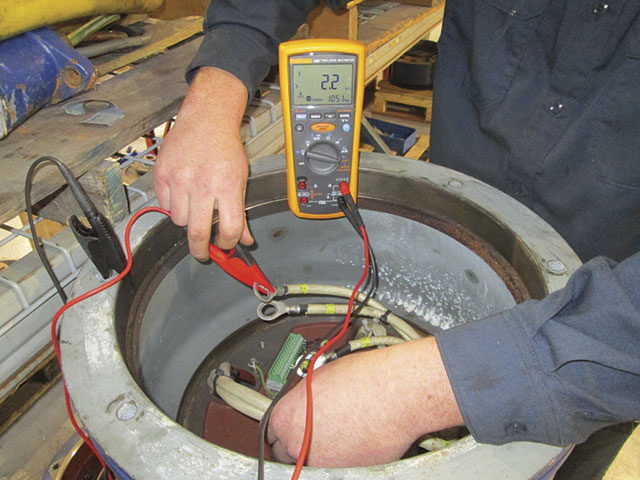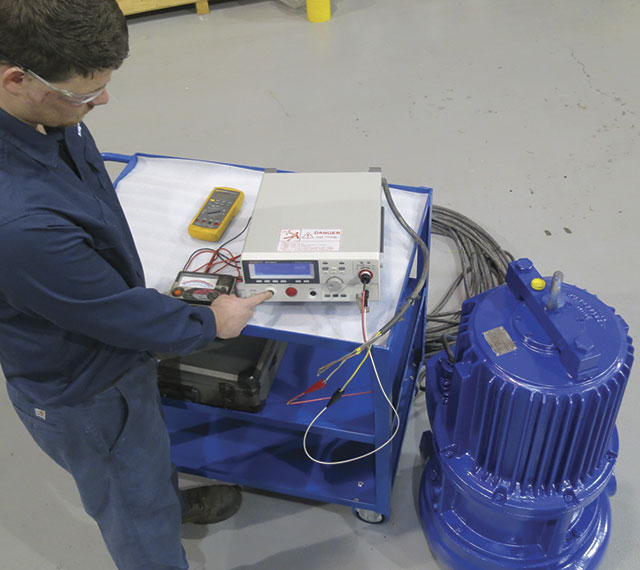Why should electrical inspections be an integral part of a pump maintenance routine? The answer is simple: Performing electrical inspections on pumps and their systems helps locate faults before they become failures. This allows the maintenance technician to order parts or replacement pumps and schedule system maintenance in advance to avoid costly downtime and emergency repairs.
Electrical inspections can provide a great deal of information about the overall condition of the pumping system. This is especially true for submersible pumps in which the motor and the pump are packaged as a single unit. Most of these pumps are equipped with internal sensors for winding temperature, bearing temperature and the presence of moisture. During the last five years, vibration sensors have become standard equipment in larger pumps. The information these sensors provide can mean the difference between a simple rebuild or stator rewind and rotor replacement. Regular electrical inspections can help reduce each pump\'92s total cost of ownership (TCO).
 Image 1. A Megger test in action (Images courtesy of KSB)
Image 1. A Megger test in action (Images courtesy of KSB)Offline Testing
During a motor inspection, several tests are performed on the stator windings. A multimeter can be used to test the resistance of the coils and compare them to each other. For single-phase motors, the resistance readings can be compared to an ohms chart provided by the manufacturer. In three-phase motors the resistance (ohms) on each phase should be within 2 percent. Shorts to ground can only be found with a multimeter if there is a direct short. Other conditions, such as moisture, dirt or carbonization, may not be detectable. When electrical arcing occurs between the windings and ground or between coils, the insulation of the windings becomes carbonized, basically turning the material into a semiconductor. A semiconductor acts like an insulator until a barrier potential voltage is reached. Then, it shorts and behaves like a conductor.
In the case of carbonized winding insulation, a multimeter cannot detect the ground fault because the test voltage of the meter (9-10 volts [V] direct current [DC]) is too low to reach the barrier potential of the carbonized insulation. In the past, a hipot test was used to find ground shorts. During a hipot test, a high voltage potential (2,000 V) is placed across the windings, and leakage through the insulation is measured to determine the condition of the insulation (see Image 2, page 80). Unfortunately, these testers can damage the windings over time. If moisture or dirt is present, the hipot may cause an arc to flash, instantly ruining the windings. Hipot tests are used at factories to determine the dielectric breakdown voltage of new windings. A hipot test is also required for explosion-proof certification.
In 2015, a Megger (a registered trademark of the Megger Corporation) is used to test for shorts to ground. Megger tests work by sending a low-amperage (0.001 amps) pulse of DC voltage between the coil leads and the stator ground at two times the motor's operating voltage (250-1,000 V).
The Megger displays the results in megaohms (see Image 1). Readings from the Megger can determine whether there is a direct short to ground or an insulation fault in the windings, such as moisture or dirt. In the case of moisture or dirt, the stator can be washed, dried and re-dipped in varnish to save the owner from an expensive rewind.
For coil-to-coil and turn-to-turn shorts, multimeters and Meggers can only detect a major short. For minor shorts, a coil and winding tester is needed. When a small turn-to-turn fault occurs, there is typically only a tiny change to the DC resistance. With larger motors this change can be too small to detect with an ordinary multimeter.
To find the short, the end user must look at the difference between the alternating current (AC) resistance (inductance) and the DC resistance. While the DC resistance may change slightly because of a minor short, the AC resistance will vary greatly with frequency. Minor shorts can be easily detected by comparing the three windings while testing a range of frequencies. Two types of coil and winding testers are available. Both types input a low voltage AC signal and read the output. A surge tester—the most common style of coil tester—has a screen that displays the waveform as the tester steps through the frequencies. Other types calculate the differential internally and display the results on a screen.
Online Testing
The most exciting new development in the world of pump electrical maintenance is the development of online testing. This new breed of instruments can be attached to a pumping system to monitor the pump and motor while they are running. The temperature, vibration, flow, pressure, power and electrical waveforms can be analyzed using online testing.
 Image 2. Hipot testing performed on a submersible pump stator
Image 2. Hipot testing performed on a submersible pump statorOn the motor side, users can detect problems with incoming power, bearings, stator shorts, and dirty or wet windings. On the pump side, the intake pressure, discharge pressure, fluid temperature, flow rate, bearing condition and vibration can be measured.
Another feature of online testing—known as data logging—is the ability to collect measurements over a period of time. The majority of pump system problems happen when an operator is not present—the "ghost" failures that occur in the late hours of the night. Data logging can monitor multiple channels of information for long periods of time to capture these events as they happen. Examining data logger records collected over extended periods can also reveal trends that point to gradual deterioration of pump or motor conditions before they become critical.
A data logger can also show the operating parameters of the pump system and help end users evaluate the exact duty point and duty cycles of the system. Comparing this information with the manufacturer's pump curves, end users can determine with high accuracy where the pump is operating on the curve, measure the system curve and determine where the motor is running on the power curve.
This information shows the effects of pump wear, pipe restrictions and suction issues. This information can also be used to accurately calculate the pump system efficiency, which allows the engineer to offer solutions that can improve efficiency, reduce wear and decrease downtime.


